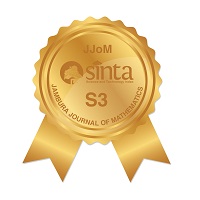Analisis Dampak COVID-19 dan Faktor-Faktor yang Mempengaruhi Indeks Saham Bank Jatim Menggunakan Pendekatan Regresi Time Series
Abstract
Keywords
Full Text:
PDFReferences
A. Bodie, A. Kane, and A. J. Marcus, Essentials of Investment: Global Edition, 9th ed. United States of America: McGraw Hill Higher Education, 2013.
V. Sukmaningati and F. Ulya, "Keuntungan Investasi di saham syariah" Jurnal Investasi Islam, vol. 5, no. 1, pp. 59-68, jan 2021, doi: http://dx.doi.org/10.32505/jii.v5i1.1648.
D. Tambunan, "Investasi Saham di Masa Pandemi COVID-19" Widya Cipta: Jurnal Sekretari dan Manajemen, vol. 4, no. 2, pp. 117-123, sep 2020, doi: http://dx.doi.org/10.31294/ widyacipta.v4i2.8564.
H. Saraswati, "Dampak Pandemi Covid-19 Terhadap Pasar Saham di Indonesia" JAD J. Ris. Akunt. dan Keuang. Dewantara, vol. 3, no. 2, pp. 153-163, 2020.
H. Habiburrahman, "Analisis Pengaruh Nilai Tukar Rupiah Dan Inflasi Terhadap Indeks Harga Saham Sektor Properti Di Bursa Efek Indonesia" J. Manaj. dan Bisnis Univ. Bandar Lampung, vol. 5, no. 2, pp. 112-129, 2015.
F. Sholihat, "Pengaruh Inflasi, Tingkat Suku Bunga Sertifikat Bank Indonesia & Indeks Harga Saham Gabungan Terhadap Tingkat Pengembalian Reksadana Saham (Studi Pada Bursa Efek Indonesia Periode 2011-2013)" J. Adm. Bisnis, vol. 21, no. 1, pp. 1-7, 2015.
M. Fathurahman and H. Haerudin, "Pemodelan Regresi Linier untuk Data Deret Waktu" J. Eksponensial, vol. 2, no. 2, pp. 36-41, 2011.
P. Kartikasari, "Peramalan Indeks Harga Saham Gabungan (IHSG) Guna Deteksi Dini Stabilitas Ekonomi Menggunakan Metode Regresi Time Series" J. Stat. Univ. Muhammadiyah Semarang, vol. 7, no. 2, pp. 108-115, 2019.
R. E. Wulansari, E. Suryanto, K. Ferawati, I. Andalita, and S. Suhartono, "Penerapan Time Series Regression with Calendar Variation Effect pada Data Netflow Uang Kartal Bank Indonesia Sebagai Solusi Kontrol Likuiditas Perbankan di Indonesia" Statistika, vol. 14, no. 2, pp. 59-68, 2014.
R. E. Walpole, R. H. Myers, S. L. Myers, and K. Ye, Probability and Statistics for Engineers and Scientists, 9th ed. Boston: Pearson Prentice Hall, 2011.
A. N. Wijiyanto, D. E. Kusrinid, and I. Irhamah, "Peramalan Nilai Kontrak Konstruksi PT "˜X'dengan Menggunakan Pendekatan Regresi Time Series dan ANFIS" J. Sains dan Seni ITS, vol. 1, no. 1, pp. 201-206, 2012, doi: http://dx.doi.org/10.12962/j23373520.v1i1.1982.
M. R. Susila, R. C. Putri, and D. Arini, "Pemodelan Regresi Spasial Investasi Luar Negeri yang Masuk ke Indonesia" BAREKENG: Jurnal Ilmu Matematika dan Terapan, vol. 14, no. 4, pp. 543-556, dec 2020, doi: http://dx.doi.org/10.30598/barekengvol14iss4pp543-556.
N. W. Ayuni, "Pemodelan Angka Harapan Hidup di Provinsi Jawa Timur Tahun 2007 dan 2011 Berdasarkan Angka Melek Huruf, Rata-rata Lama Sekolah, dan Pengeluaran Perkapita" J. Mat., vol. 3, no. 1, pp. 12-23, 2013.
E. Supriyadi, S. Mariani, and S. Sugiman, "Perbandingan Metode Partial Least Square (PLS) dan Principal Component Regression (PCR) Untuk Mengatasi Multikolinearitas Pada Model Regresi Linear Berganda" Unnes Journal of Mathematics Education, vol. 6, no. 2, pp. 117-128, 2017.
T. A. Prasanti, T. Wuryandari, and A. Rusgiyono, "Aplikasi Regresi Data Panel untuk Pemodelan Tingkat Pengangguran Terbuka Kabupaten/Kota di Provinsi Jawa Tengah" J. Gaussian, vol. 4, no. 3, pp. 687-696, 2015.
W. Aryanto and R. D. Handaka, "Analisis Pengaruh Belanja Modal, Indeks Pembangunan Manusia, dan Tenaga Kerja Terserap Terhadap Pertumbuhan Ekonomi Kabupaten/Kota Di Indonesia" J. Akunt. Manajerial, vol. 2, no. 2, pp. 52-63, 2017.
M. R. Susila, "Pengaruh Hari Raya Idul Fitri Terhadap Inflasi di Indonesia dengan Pendekatan ARIMAX (Variasi Kalender)" BAREKENG: Jurnal Ilmu Matematika dan Terapan, vol. 14, no. 3, pp. 369-378, oct 2020, doi: http://dx.doi.org/10.30598/ barekengvol14iss3pp369-378.
"”"”, "Pemodelan Multivariate Kunjungan Wisatawan Mancanegara ke Indonesia Melalui Pintu Udara, Laut, dan Darat yang Melibatkan Dampak Wabah COVID-19" BAREKENG: Jurnal Ilmu Matematika dan Terapan, vol. 15, no. 3, pp. 467-478, sep 2021, doi: http://dx.doi.org/10.30598/barekengvol15iss3pp467-478.
DOI: https://doi.org/10.34312/jjom.v4i2.13401
Copyright (c) 2022 Muktar Redy Susila, Mochamad Jamil, Bambang Hadi Santoso

This work is licensed under a Creative Commons Attribution-NonCommercial 4.0 International License.
Jambura Journal of Mathematics has been indexed by
Jambura Journal of Mathematics (e-ISSN: 2656-1344) by Department of Mathematics Universitas Negeri Gorontalo is licensed under a Creative Commons Attribution-NonCommercial 4.0 International License. Powered by Public Knowledge Project OJS.
Editorial Office
Department of Mathematics, Faculty of Mathematics and Natural Science, Universitas Negeri Gorontalo
Jl. Prof. Dr. Ing. B. J. Habibie, Moutong, Tilongkabila, Kabupaten Bone Bolango, Gorontalo, Indonesia
Email: [email protected].



















